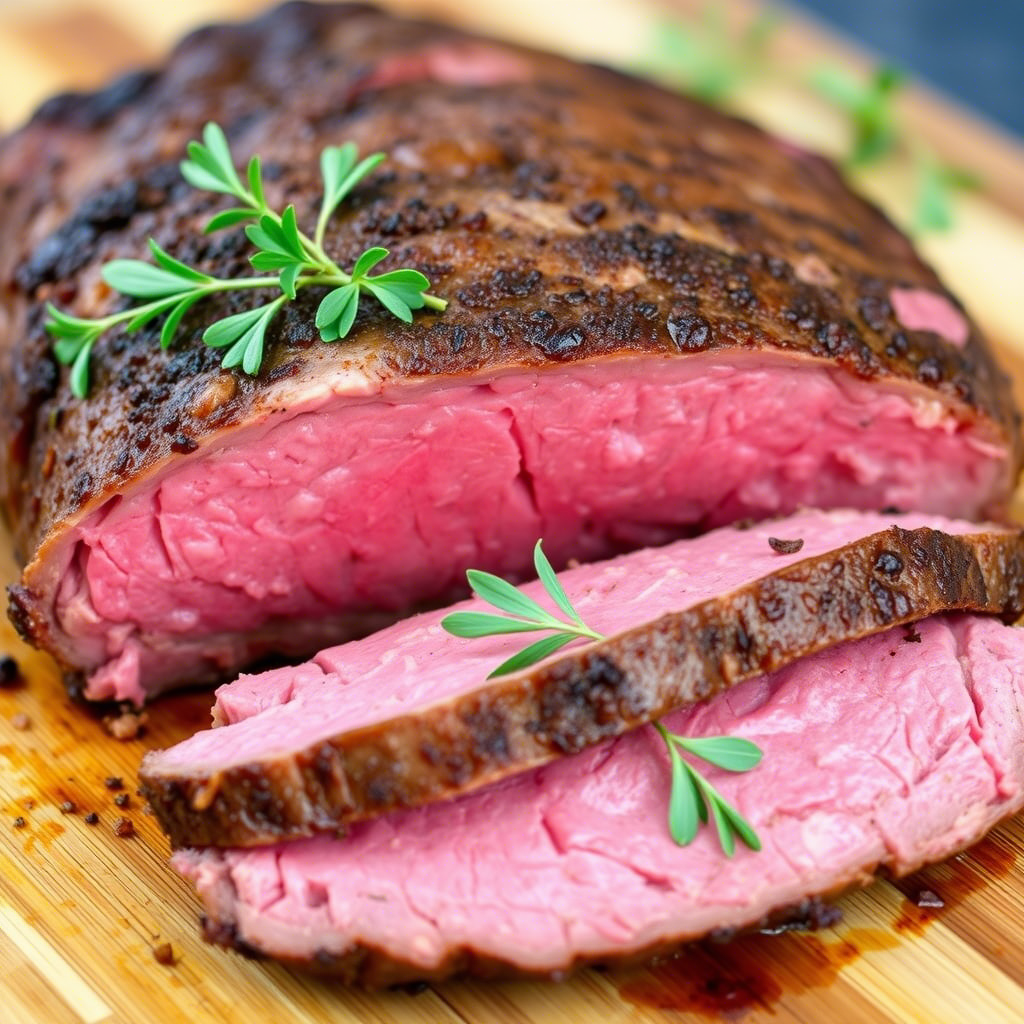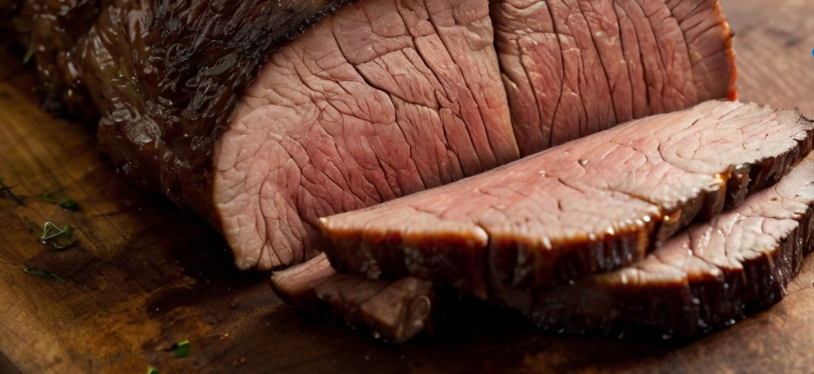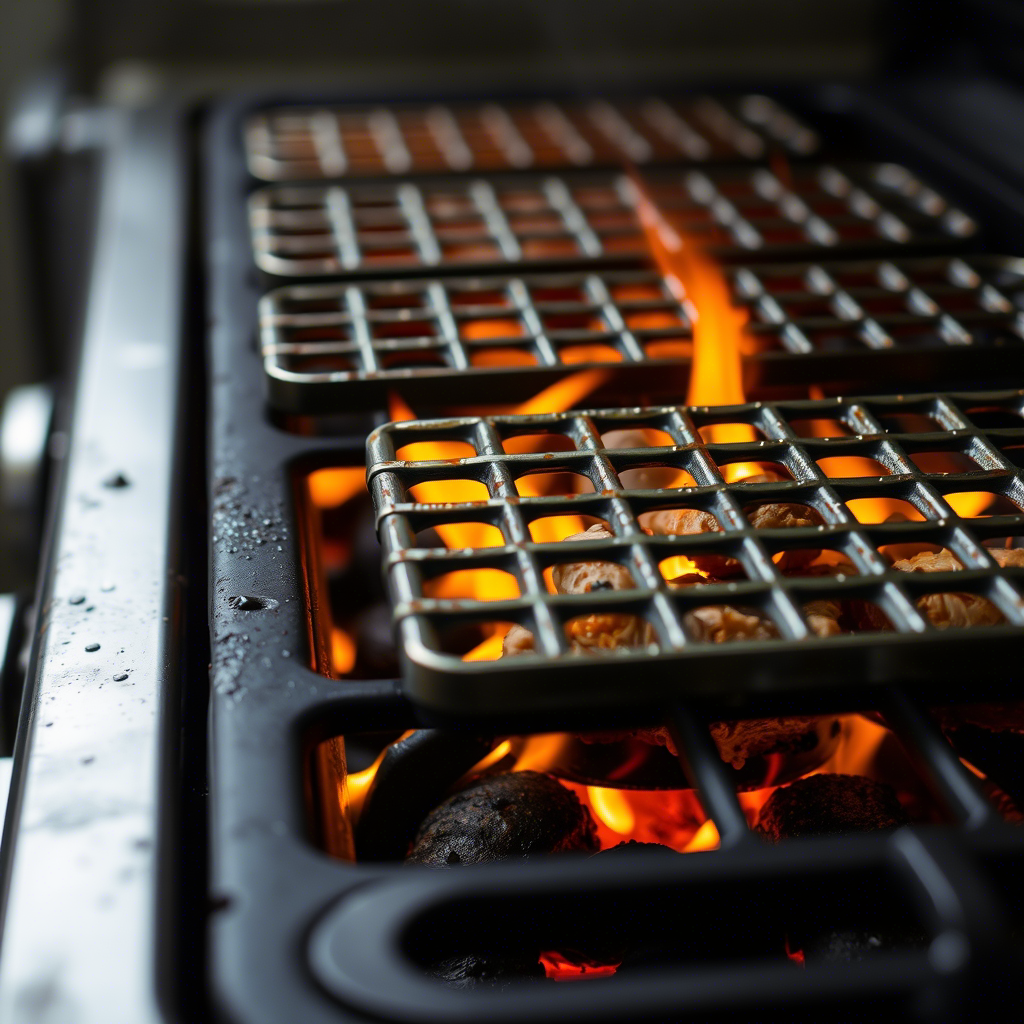

Let me tell you right away — beef bottom round roast is one of those cuts that teaches you patience, skill, and respect for the animal. It’s a humble, lean piece of meat from the rear leg of the cow, often overlooked because it doesn’t have the marbling of pricier steaks or rib roasts. But for me, that’s exactly where the magic lies.
Cooking this cut properly is a small victory every time. It’s about knowing how to work with what you’ve got — coaxing tenderness out of toughness, building deep flavor, and making a meal that feels like pure comfort.
This guide is all about sharing what I’ve learned over years in the kitchen — not fancy restaurant tricks, but real techniques anyone can use at home to turn this economical roast into something unforgettable.
Ready to dive in?
- What is Bottom Round Roast?
- Features and Challenges of Cooking
- Preparation Tips
- Marination Techniques
- Dry Rubs & Seasonings
- Cooking Methods
- Oven Roasting
- Slow Cooker
- Sous Vide
- Pan Searing + Oven Finish
- Recipes
- Classic Herb Roast
- Marinated Tender Roast
- Garlic Butter Roast
- Storage and Reheating
- How to Store Leftovers
- Reheating without Drying
- FAQ — Frequently Asked Questions about Beef Bottom Round Roast

Best Way to Cook a Beef Bottom Round Roast – Chef’s Tips & Tricks
What is Bottom Round Roast?
The bottom round roast comes from the back leg of the cow — right from the hardworking muscle that does a lot of moving. That tells you two things immediately: this cut is lean, and it’s tough. There’s very little fat running through it, and that’s why most people pass it by at the butcher shop. Mistake!
See, to me, bottom round is honest meat. It doesn’t pretend to be melt-in-your-mouth like a ribeye. It needs your attention, your patience, and a little bit of love to shine. But when you do it right? Oh, it rewards you with bold beefy flavor that feels like home cooking at its finest.
If you’ve ever had classic roast beef — like the kind thinly sliced in a sandwich — there’s a good chance you’ve tasted bottom round already. It’s affordable, it feeds a crowd, and when treated properly, it slices beautifully.
But — and this is important — you can’t rush it. It’s a cut that needs either low and slow cooking, or clever tricks to break down those muscle fibers.
Features and Challenges of Cooking
Let me be straight with you — bottom round roast is not a “throw it in the oven and forget it” kind of meat. It’s a cut that demands respect. If you treat it like a prime rib, it’ll fight back. Dry, chewy, disappointing. Been there, done that (years ago… never again).
The Main Features:
- Very lean
- Dense muscle fibers
- Deep, rich beefy taste
- Large, affordable cut
The Main Challenges:
- Dries out easily
- Tough if undercooked or overcooked
- Needs help staying moist and tender
So what does that mean for us in the kitchen?
→ You can’t rely on fat to keep it juicy — you have to create that moisture.
→ You need either a smart marinade, a slow cook, or very precise roasting.
→ Slicing thin is non-negotiable — that’s how this roast really shines on the plate.
But here’s the fun part: once you know how to handle it, bottom round roast becomes incredibly rewarding. It’s a cut that transforms under your hands. It’s what I call “real cooking” — where skill matters more than price.
Preparation Tips
When I get my hands on a bottom round roast, I treat it like a project. The preparation stage is where you either set yourself up for success… or for chewing forever.
My Golden Rule: Never Cook It Straight Out of the Fridge.
Let it sit at room temperature for about 45 minutes. That way it cooks more evenly, and you avoid that cold-core problem.
Now, let’s talk about two main preparation routes: marinating and dry rubs.
Marination Techniques
Why Marinate?
Simple — acid breaks down muscle fibers, adding tenderness. Flavors soak in. Moisture stays locked.
But I’ve got a little trick for you…
Using Kiwi or Pineapple to Tenderize
Sounds crazy? Trust me, this comes from experience. Both kiwi and pineapple have natural enzymes (actinidin in kiwi, bromelain in pineapple) that break down meat fibers beautifully.
→ The key: only use them for a short time — 30 minutes MAX — or the meat can turn mushy.
How to Do It:
- Mash 2 slices of kiwi or pineapple.
- Rub directly on the roast surface.
- Let it sit for 30 minutes in the fridge.
- Rinse it off completely.
- Pat dry and proceed with your real marinade or rub.
Best Marinade Recipes
Here’s my go-to marinade when I want a tender and flavorful bottom round:
Ingredients:
- 4 tbsp olive oil
- 3 tbsp soy sauce
- 2 tbsp balsamic vinegar
- 2 tsp Dijon mustard
- 3 garlic cloves, minced
- 1 tsp black pepper
- 1 tsp salt
- 1 tsp rosemary (fresh or dried)
Steps:
- Mix everything in a bowl.
- Place roast in a ziplock bag or deep dish.
- Pour marinade over it.
- Refrigerate for at least 4 hours, best overnight.
- Pat dry before cooking (important for searing).
Dry Rubs & Seasonings
If I don’t marinate, I go dry rub. The secret here is simple flavors, but enough salt to help the crust.
My Favorite Dry Rub:
- 2 tsp salt
- 2 tsp cracked black pepper
- 1 tsp garlic powder
- 1 tsp smoked paprika
- ½ tsp ground mustard
- ½ tsp thyme
Steps:
- Rub all over the roast generously.
- Let it sit uncovered in the fridge for a few hours (or overnight).
- This also dries the surface for a killer sear.
Cooking Methods
Alright, now we get to the fun part — cooking that beautiful bottom round roast. I’ll walk you through the four methods I trust most. Each has its strengths, and I’ve used them all depending on my mood, my time, and my tools.
Oven Roasting
This is the classic way. Nothing fancy. Just heat, patience, and a good meat thermometer.
How I Do It:
- Preheat your oven to 230°C (450°F).
- Place roast on a rack in a roasting pan — fat side up if it has one.
- Roast uncovered for 15 minutes (this builds a crust).
- Lower the oven to 135°C (275°F).
- Continue roasting until desired doneness (see my table below).
- Rest for at least 20 minutes, tented with foil, before slicing thinly.
Temperature & Time Table
Measuring a right temperature is very important for this dish. You need to know exactly what you want to prepare, otherwise you will end up with bogus.

| Doneness | Oven Temp | Time per 500g (1.1 lb) | Internal Temp |
|---|---|---|---|
| Rare | 120°C / 250°F | 20–25 min | 50°C / 122°F |
| Medium | 135°C / 275°F | 30–35 min | 60°C / 140°F |
| Well Done | 150°C / 300°F | 40–45 min | 70°C / 158°F |
→ Always check with a meat thermometer for accuracy.
Slow Cooker
Lazy day magic. Great for guaranteed tenderness, but expect more of a pot roast texture.
How I Do It:
- Sear roast on all sides in a hot pan (optional but I recommend it).
- Place in slow cooker.
- Add: 1 cup beef broth, 1 onion (sliced), 3 garlic cloves, and a splash of soy sauce or Worcestershire.
- Cook on LOW for 8-9 hours.
- Slice or shred, depending on how tender it got.
Sous Vide
Honestly? This method feels like cheating — perfect edge-to-edge doneness.
How I Do It:
- Season roast with salt, pepper, and garlic.
- Vacuum-seal or place in a ziplock (water displacement method).
- Sous vide at 54°C (130°F) for 24-30 hours.
- Remove, pat dry, and sear in a blazing hot pan for 1-2 minutes per side.
- Slice thin and marvel at the tenderness.
Pan Searing + Oven Finish
This is my weeknight method when I want speed but still crave that roast flavor.
How I Do It:
- Preheat oven to 135°C (275°F).
- Sear roast in a cast-iron pan — 2 minutes per side until brown.
- Transfer the whole pan to the oven.
- Roast until internal temp hits your target (see table above).
- Rest well, then slice thin.
Recipes
These are my personal bottom round roast recipes I’ve cooked countless times for family, friends, and yes — some picky guests too. All recipes use simple ingredients and step-by-step instructions anyone can follow.
Classic Herb Roast
Straightforward. Aromatic. Reminds me of Sunday dinners growing up.
Ingredients:
- 1.5 kg beef bottom round roast
- 2 tbsp olive oil
- 2 tsp salt
- 1 tsp black pepper
- 1 tsp garlic powder
- 1 tsp dried rosemary
- 1 tsp dried thyme
Steps:
- Take roast out of the fridge 45 minutes before cooking.
- Preheat oven to 230°C (450°F).
- Rub roast with olive oil all over.
- Mix salt, pepper, garlic powder, rosemary, and thyme in a small bowl.
- Rub seasoning mix evenly over roast.
- Place roast on a rack in a roasting pan.
- Roast for 15 minutes.
- Lower heat to 135°C (275°F) and continue roasting until internal temp is 57°C (135°F) for medium.
- Rest 20 minutes before slicing thinly across the grain.
Marinated Tender Roast
This one never fails when tenderness is my top priority.
Ingredients for Marinade:

4 tbsp olive oil
3 tbsp soy sauce
2 tbsp balsamic vinegar
2 tsp Dijon mustard
3 garlic cloves, minced
1 tsp black pepper
1 tsp salt
Steps:
- Mix all marinade ingredients in a bowl.
- Place roast in a ziplock bag or deep dish.
- Pour marinade over roast.
- Refrigerate overnight (minimum 4 hours).
- Next day, remove roast, pat dry completely.
- Sear in a hot pan for 2 minutes per side.
- Roast in oven at 135°C (275°F) until internal temp is 57°C (135°F).
- Rest 20 minutes before slicing.
Garlic Butter Roast
Rich, flavorful, and smells heavenly while cooking.
Ingredients:
- 1.5 kg beef bottom round roast
- 3 tbsp butter (softened)
- 3 garlic cloves, minced
- 1 tsp salt
- 1 tsp black pepper
- 1 tsp fresh parsley (chopped)
Steps:
- Mix butter, garlic, salt, pepper, and parsley together.
- Rub roast with the garlic butter mixture.
- Preheat oven to 230°C (450°F).
- Place roast on rack in roasting pan.
- Roast 15 minutes at 230°C (450°F).
- Lower oven to 135°C (275°F) and continue roasting until internal temp is 57°C (135°F).
- Rest for 20 minutes under foil.
- Slice thin and spoon any melted garlic butter over the meat.
Storage and Reheating
Bottom round roast is one of those cuts that makes amazing leftovers — if you store and reheat it right. Otherwise, it can go from tender to rubber in a heartbeat. Let me show you how I personally handle it in my kitchen.
How to Store Leftovers
- Let the roast cool completely at room temperature (but not longer than 2 hours).
- Slice the roast thinly — always across the grain.
- Place slices in an airtight container or wrap tightly in foil.
- Add a few spoonfuls of leftover juices or broth over the meat (this protects against drying).
- Store in the fridge for up to 4 days.
- For longer storage — freeze slices in ziplock bags, laying them flat. They’ll last 2-3 months.
Reheating without Drying
This is where most people go wrong — nuking the life out of their roast in a microwave. Here’s how I do it for perfect results.
Method 1: Gentle Stovetop Steam (Best for Small Portions)
This is also a traditional way of making it, actually.
- Place sliced meat in a pan.
- Add a splash of beef broth or water (about 1-2 tbsp).
- Cover with lid.
- Heat over low flame for 2-3 minutes until just warmed through.
Method 2: Oven Reheat (Best for Larger Amounts)
A method if you need to cook a lot of this roat, but in a short time. It leads to maybe slightly less quality of frying, but much better for a big amount of people. Most will never notice the dfference – trust me, I’ve done it all the time.
- Preheat oven to 120°C (250°F).
- Place slices in a baking dish.
- Add broth or pan juices to cover the bottom.
- Cover tightly with foil.
- Heat for 10-15 minutes until warm.
Method 3: Sous Vide Reheat (Luxury Option)
Very nice, but takes a long time sadly.
- Place slices in a ziplock bag.
- Submerge in hot water bath at 55°C (130°F) for 20-30 minutes.
- Perfectly reheated without losing moisture.
FAQ — Frequently Asked Questions about Beef Bottom Round Roast
Is bottom round roast a tough cut of meat?
Yes, by nature it’s lean and muscular — not naturally tender like ribeye. But with the right marination, slow cooking, and slicing technique, it becomes beautifully tender and flavorful.
What’s the best internal temperature for bottom round roast?
In my experience:
- Rare → 52-55°C (125-130°F)
- Medium → 57-60°C (135-140°F)
- Well Done → 65°C+ (150°F+)
I strongly recommend aiming for medium (57°C / 135°F) for the perfect balance of tenderness and juiciness.
Can I cook bottom round roast without marinating?
Absolutely. A good dry rub with salt, pepper, and herbs will still give you great flavor. But if you want maximum tenderness — marination (especially overnight) makes a big difference.
How thin should I slice it?
Always slice as thin as you can manage — ideally 2-3 mm. And always, always against the grain. This breaks up muscle fibers and makes each bite feel softer.
What’s the worst mistake when cooking bottom round roast?
Rushing it. This cut hates high heat for long periods. It’s made for low and slow cooking, resting properly, and slicing carefully. If you blast it in a hot oven and slice it right away — you’ll end up with leather.
Can I use this cut for sandwiches?
Oh yes — it makes fantastic roast beef sandwiches. Thin slices, a little mustard or horseradish, good bread, maybe some pickles… pure joy.